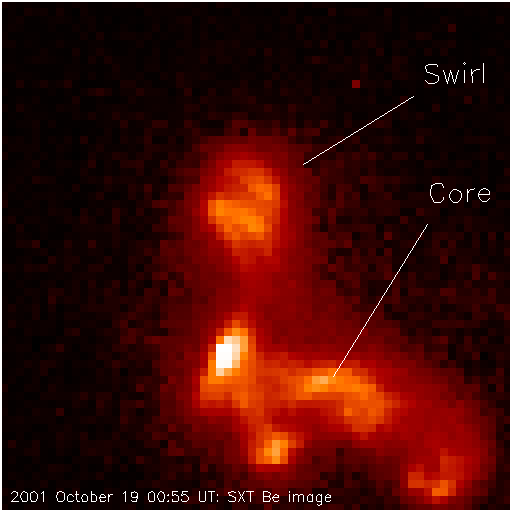
Javascript (~2.8MB) or mpeg (~380kB)
This Yohkoh science nugget marks the beginning of the fifth year of weekly nugget-writing. Just to reminisce a bit, this style of reporting surprised its authors for its usefulness and, well, its richness. It is true that the main authors are few in number, so there is probably more than a bit of personal focus in the nugget topics, but really there is a wide range. Probably the weak point of the presentations, which we perpetually struggle against, is an overly technical approach - it is really hard to avoid this in a research environment. Be sure to complain if you see something like this!
This week we note with a sign of relief the return of X-class flares. On October 19, 2001, two X-class flares occurred in the same active region, AR 9661 (see the soft X-ray light curve for orientation). To have more than one X-class flare in the same day is unusual, but it has already happened this year (2001 April 2), when AR 9393 produced three X-class flares including the uniquely powerful X20 event . Let's look at the first event of 2001 October 19.
A swirling flare?
The first of these events, shown in the movie below, warrants a second look.

The movie shows many things - at the top, a "bouncing ball" indication of the time of each X-ray image; below, wide-angle (about 10 arc min field) and narrow-angle (about 2.5 arc min field) views of the flare. The wide field of view often shows flare ejecta in such a case, almost always involving a coronal mass ejection (CME) for a flare of this magnitude; here however, though artful, the wide field mainly illustrates saturation spikes and other artifacts showing how difficult it is to image an object with such a huge dynamic range.
The small field of view, though, shows something intriguing. One can see a swirling motion moving counterclockwise above and to the left of the core loops of the flare. These motions appear to combine "parallel" and "perpendicular" effects, where this is the plasma-physics description of motions along and orthogonal to the magnetic field. Perpendicular motions, of course, could also be described as moving field lines, something we frequently see. This snapshot identifies the swirling source and the flare core:

The intriguing thing we're noticing is the relatively slow speed
of this swirling, as well as its swirling nature, of course.
We are seeing something on the order of 100 km/s.
Characteristic theoretical speeds of motion might be the
Alfven speed,
at a guess 5,000 km/sec here, or perhaps the
sound speed
of a few hundred km/s.
Of course we don't know the true speed because of projection effects.
But we know that something as yet unexplained theoretically must be
happening as the flare brightens.
This something must involve twist in the magnetic field, which
stores energy prior to its release.
This twisted geometry (we often call it a flux rope) is a geometrical
helix (we often argue about how tightly it might be wound).
How does such a structure erupt, something we often observe, while leaving
its geometry only partly disrupted?
One is tempted to ask how a
DNA molecule replicates, since this also must involve zipping a
helix open without destroying it.
The analogy is probably so weak as to be irrelevant, alas!
However in this flare again the swirling motion may again be a hint of
helicity
in a flare/CME source.
Conclusions
This flare showed us something interesting, but more from a suggestive rather than conclusive point of view. At some point we will understand enough about the plasma motions at the core of a flare, where intense energy release must be related to drastic restructuring, to identify the presently unknown mechanisms of instability and eruption.